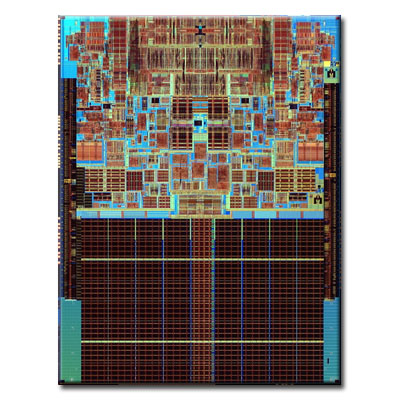Intel Core 2 Extreme (Conroe XE) processors
Introduction: July 2006
Overview
The Core 2 brand refered to a range of Intel's consumer 64-bit dual-core and 2x2 MCM quad-core CPUs with the x86-64 instruction set, based on the Intel Core microarchitecture, derived from the 32-bit dual-core Yonah laptop processor. Note: the Yonah's silicon chip or die comprised two interconnected cores - each similar to those branded Pentium M. The 2x2 MCM dual-die quad-core CPU had two separate dual-core dies (CPUs) - next to each other - in one quad-core MCM package. The Core 2 relegated the Pentium brand to a lower-end market, and reunified laptop and desktop CPU lines, which previously had been divided into the Pentium 4, D, and M brands.
The Core microarchitecture returned to lower clock speeds and improved processors' usage of both available clock cycles and power compared with preceding NetBurst of the Pentium 4/D-branded CPUs. Core microarchitecture provided more efficient decoding stages, execution units, caches, and buses, reducing the power consumption of Core 2-branded CPUs, while increasing their processing capacity.
The Core 2 brand was introduced on July 27, 2006 comprising the Solo (single-core), Duo (dual-core), Quad (quad-core), and Extreme (dual- or quad-core CPUs for enthusiasts) branches, during 2007.
The Core 2-branded CPUs included: "Conroe" and "Allendale" (dual-core for higher- and lower-end desktops), "Merom" (dual-core for laptops), "Kentsfield" (quad-core for desktops), and their variants named "Penryn" (dual-core for laptops), "Wolfdale" (dual-core for desktops) and "Yorkfield" (quad-core for desktops). Note: for the server and workstation "Woodcrest", "Clovertown", and "Tigerton" CPUs saw the Xeon brand.
The Core 2 branded processors featured the Virtualization Technology (except T52x0, T5300, T54x0, T55x0 with stepping "B2", E2xx0, E4x00 and E8190 models), Execute Disable Bit, and SSE3. Their Core microarchitecture introduced also SSSE3, Trusted Execution Technology, Enhanced SpeedStep, and Active Management Technology (iAMT2). With a Thermal Design Power (TDP) of up to only 65W, the Core 2 dual-core Conroe consumed only half the power of less capable, but also dual-core Pentium D-branded desktop chips with a TDP of up to 130W (a high TDP requires additional cooling that can be noisy or expensive).
The Conroe XE core
The Core 2 Extreme was officially released on July 29, 2006. However some retailers appeared to had released it on July 13, 2006, though at a higher premium. The less powerful E6x00 models of Core 2 Duo were scheduled for simultaneous release with the X6800, which were both available at this time. It was powered by the Conroe XE core and replaced the dual-core Pentium Extreme Edition processors. Core 2 Extreme had a clock speed of 2.93GHz and a 1066MHz FSB, although it was initially expected to be released with a 3.33GHz and 1333MHz. The TDP for this family was 75–80 watts. With SpeedStep enabled, the average temperature of the CPU when idle was essentially that of the ambient atmosphere.
At launch time, Intel's price for the Core 2 Extreme X6800 was US$999 each in quantities of 1000. Like the desktop Core 2 Duo, it had 4MB of shared L2 cache available. This meant that the only major difference between the regular Core 2 Duo and Core 2 Extreme was the clock speed and unlocked multiplier, usual advantages of the "Extreme Edition". The unlocked upward multiplier was of use to enthusiasts as it allowed the user to set the clockspeed higher than shipping frequency without modifying the FSB unlike mainstream Core 2 Duo models which were downward unlocked only.
Source: Wikipedia, the free encyclopedia.


